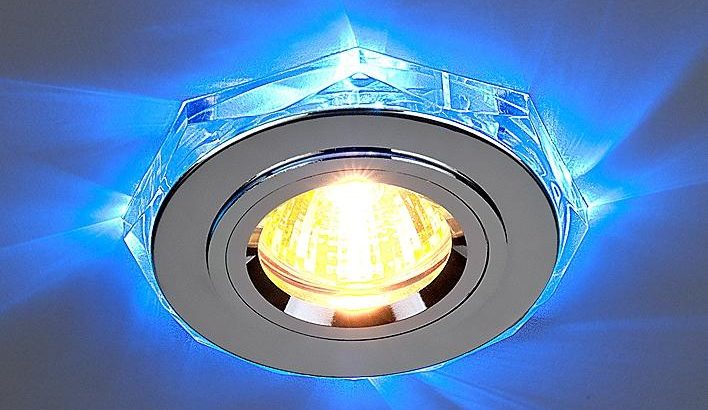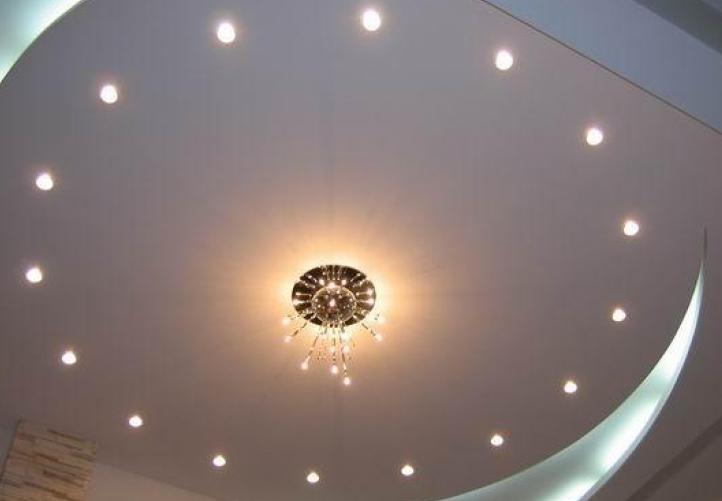What are the sizes of recessed lighting fixtures
How to choose for stretch ceilings
In order for the luminaire to fit perfectly on a suspended ceiling slab, everything has to be measured out to the centimeter. Otherwise you can damage the structure, up to and including the dismantling. The most rational option - round spotlights with a small diameter.
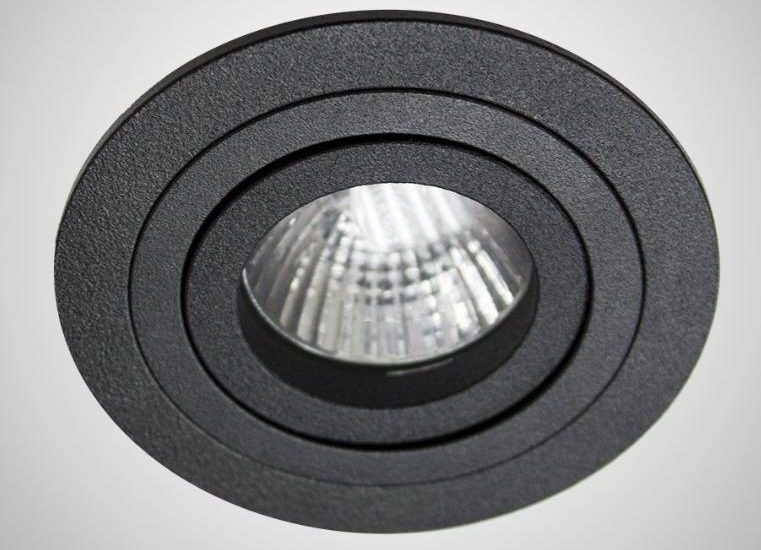
They also do not need large holes in the ceiling. The round shape minimizes the risk of damage to the ceiling. To ensure that the temperature does not rise above the marked limit of +80 ° C, it is worth using bulbs up to 60 watts for a fabric stretched surface and up to 40 watts for a film surface. For halogen lamps, the power is divided in two - 30 and 20 watts, respectively.
One of the main parameters of a light fixture for suspended or stretched ceilings is socket design. It depends on this, which lamp can be used in the lamp. And this, in turn, dictates the depth of recessed lantern (when a recessed model is used). The sockets come in the following types:
- E27 - this is the socket of a normal incandescent bulb;
- E14 - known as "mignon", the size is smaller than E27;
- G4, G5, G9 - these lamps have pins, which reduce the overall size.
Correspondence of the diameter of the lamp to the ceiling fixture
When choosing a spotlight for a suspended ceiling, you need to be guided by the fixture. It is selected by the inner diameter of the plafond part of the lamp. Standards of diameters - 60, 65, 70, 75, 80 and 85 mm. The same parameters should correspond to the holes made in the suspended ceiling and the size of the fixture.
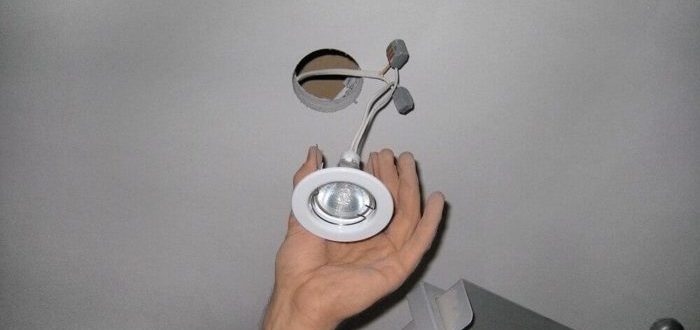
An important role is the depth of the light source. According to this parameter ceiling fixtures can be:
- Outdoor. The lamp is placed below the level of the ceiling, it covers the plafond. Such lights have a smaller size and depth of placement.
- Internal (built-in). The light source is placed inside the tension housing. This requires more luminaire size and depth.
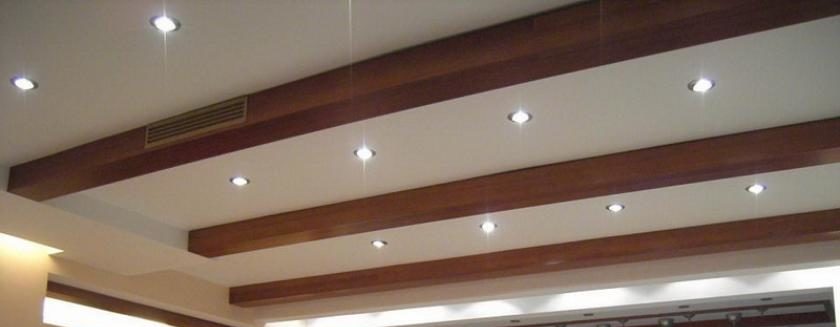
Dimensions of the lighting fixture for suspended ceilings
Suspended surfaces, finished with plasterboard or plastic, usually provide for the use of recessed lighting fixtures. There is no rigid framework in the dimensions. They, along with the depth of recessed, depend on the type of light source:
- for halogen and LED-lamps, the dimensions of the luminaire are 3-10 cm;
- for incandescent lamps - from 10 cm.
All socket types are suitable, with the exception of E27 and E14 - it is not advised to use them.. Interestingly, the distance between the suspended structure and the surface of the lamp can be both 3 cm and 10 cm. That is why different sizes of ceiling lights are suitable.
Important! The choice of fixtures for suspended and suspended ceilings is based not only on the size of the device itself, but also on the size of the room. So the device will not look out of place in the interior.
What lamps are used for tension and suspended ceilings
The main requirement for the lamp on the tension, suspended structures from GKL - it should not overheat the ceiling. The maximum allowable temperature - 70-80 ° C. Lamps that overheat - a potential threat to the suspended ceiling. Yellow stains, fabric damage, unpleasant odors - this is an incomplete list of what it is fraught with.
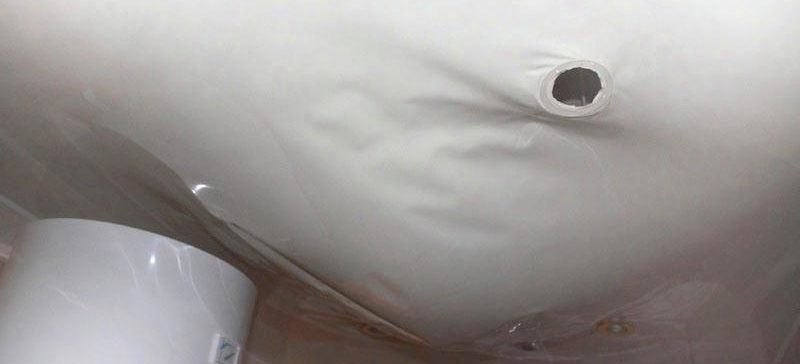
Therefore, it is better to take a lamp with low power. LED bulbs are preferred. They, firstly, do not overheat the surface, and secondly, allow you to achieve any desired variation of lighting. Built-in or overhead model of the lantern is a matter of second importance. Briefly about the most used types of lamps:
- Built-in LED (light-emitting diode). The advantages of such a lamp - long life, do not harm your eyes, do not overheat the fabric or plastic overlap even with prolonged operation. But they also have an obvious disadvantage. For uninterrupted operation, you may need to connect additional equipment (transformer).
- Built-in raster. Due to the reflective plates of the luminaire, they create scattering bright daylight. With prolonged use can have a negative effect on the eyesight.
- Diode spot lights. One popular example of use is "starry sky".
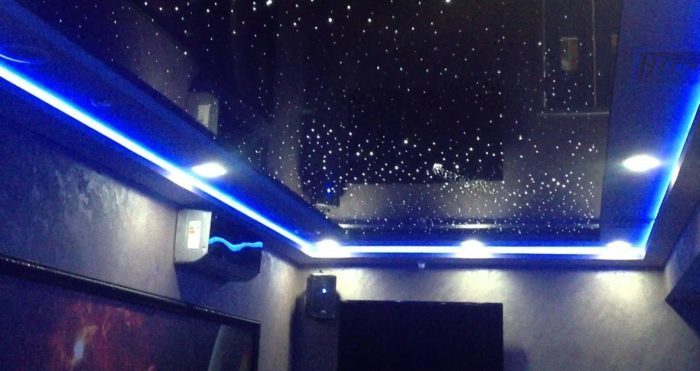
Diode lamps give soft light, long life, do not overheat the suspended ceiling.
- Spot energy-saving lamps. These lamps compared to LED lamps last longer, heat less, cost less and do not require connection to additional equipment to supply current.
- LED strips. They can be used to create light in any area of the room with adjustable power. The color is selected in accordance with the shade of the suspended ceiling. Must be connected to a transformer.
Important! When placing several lights on the suspended structure, you need to remember about 2 key points:
- The distance between adjacent lights not more than 120 cm;
- the distance from the mounting point of the luminaire to the wall does not exceed 60 cm.
Parameters of luminaires: what to pay attention to
Recessed depth
On the visual perception of the room directly affects the depth of recessed point lighting device. It sets how many centimeters the ceiling will be lowered and, accordingly, the height of the room will be reduced. Most often recessed lights are used, so between the present ceiling and suspended or stretched slatted ceiling, it is necessary to leave room for the lamp. Depending on the brand and type of lamp, the embedding depth varies between 2.5-12 cm.
Matching the length, width and shape to the size of the room
In terms of linear dimensions, ceiling lights should be selected according to the size of the room. Overly large lantern in the interior visually narrows the space.
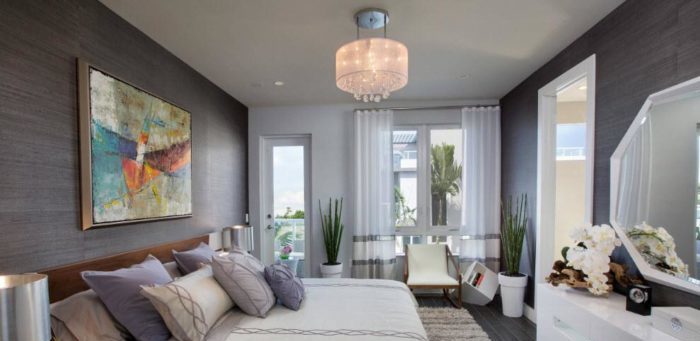
At the same time, the tiny spot will clearly not be enough to illuminate every corner of the room. Here, the principle applies: for 10 square meters you need 100-150 watts of power. The bigger the size of the spot, the better the light is diffused in the room, and a smaller load is placed on the eyes. Not the least important role is played by the design solution of the room. So, In a square room, round spotlights will look good, and in a rectangular room, square or irregularly shaped.
Height
Any spotlight has a part that hides in the recess between the stretch ceiling and the actual ceiling. This fact is necessarily taken into account when selecting the height of the light fixture. Much depends on the type of lamps used. In luminaires with incandescent lamps, the height of the hidden part can be up to 12 cm, with halogen - 5-8 cm, with LED lamps up to 6 cm. For recessed ceiling luminaires, the actual height dimensions are equivalent to the recessed depth. If the room has very high ceilings and you want to "lower" them through additional overlap, you can safely take a lamp of large size or several small ones, evenly spaced on the ceiling. With low ceilings, the story is the opposite: it is not necessary to lower them additionally.
Video: Why you can not use spotlights.
